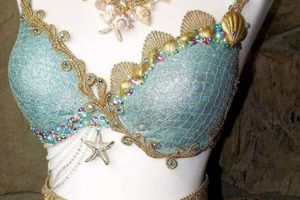The phrase denotes the creation of an underwater explorer’s attire using do-it-yourself methods. An example would be constructing air tanks from painted plastic bottles and utilizing repurposed materials for a wetsuit appearance.
The appeal of this activity lies in its cost-effectiveness and the opportunity for personalized creative expression. Historically, homemade attire has been prevalent in scenarios where commercial options are either unavailable or unaffordable, fostering resourcefulness and individual craftsmanship.
The subsequent sections will delve into the individual components needed for assembling such an outfit, alongside detailing potential safety considerations and methods for achieving realistic visual effects.
Guidance for Constructing an Underwater Explorer’s Outfit
The following tips provide guidance for constructing a convincing and safe simulated deep-sea diver’s ensemble. Attention to detail and careful material selection are paramount.
Tip 1: Tank Construction. Utilize sturdy cylindrical containers, such as plastic soda bottles. Uniformly coat them with metallic paint. Affix two containers together for a twin-tank configuration. Secure with robust adhesive.
Tip 2: Regulator Simulation. Employ flexible tubing, connecting it to a repurposed mouthpiece. This assembly creates the visual impression of a breathing apparatus. Exercise caution to prevent any blockage of airways.
Tip 3: Wetsuit Approximation. Dark-colored, close-fitting clothing serves as a foundational wetsuit. Consider adding details with fabric paint or strategically placed duct tape to mimic seams and reinforced areas.
Tip 4: Mask Creation. Adapt swim goggles by attaching darkened plastic shields to the lenses. This simulates the appearance of a diving mask. Verify adequate peripheral vision remains.
Tip 5: Fin Replication. Utilize cardboard or flexible plastic sheets to fabricate fin shapes. Attach these to footwear using secure straps. Ensure mobility is not unduly restricted.
Tip 6: Weight Belt Emulation. Fashion a belt from heavy fabric or webbing. Attach weighted items, such as painted rocks or sand-filled bags, to simulate ballast. Distribute weight evenly.
Tip 7: Material Safety. Prioritize non-toxic materials in the construction process. Thoroughly inspect all components for sharp edges or potential hazards before assembly and wear.
These guidelines emphasize safety and visual realism, facilitating the construction of a compelling facsimile of diving gear.
The subsequent section will address potential embellishments and advanced techniques for further enhancing the authenticity of the constructed attire.
1. Material Selection
Material selection is paramount in the construction of a simulated deep-sea divers ensemble. The choice of materials directly impacts the costume’s visual fidelity, safety, and structural integrity. The following points elaborate on key facets of material selection in the context of this endeavor.
- Paint Composition
The selection of paint is a primary consideration. Non-toxic, water-based acrylic paints are preferable for safety reasons, mitigating the risk of harmful chemical exposure. Furthermore, metallic paints can effectively simulate the appearance of metal components on air tanks or regulators. Durability is important, so paints with weather resistance are chosen.
- Fabric Properties
Fabric choice significantly affects the realism of the wetsuit component. Stretchy, dark-colored fabrics such as spandex or neoprene remnants provide a close-fitting silhouette and mimic the appearance of professional diving suits. Breathability, though less critical than in functional apparel, is still a consideration to prevent overheating during prolonged wear.
- Plastic Type
Rigid plastic containers, such as repurposed bottles, are often used for constructing simulated air tanks. The chosen plastic should be durable enough to maintain its shape and resist deformation. Avoid thin plastics that crush easily. Furthermore, the plastic should accept paint well to allow for a convincing metallic finish.
- Adhesive Strength
Adhesive selection is critical for securing various components, such as connecting simulated air tanks or attaching fins to footwear. A strong, flexible adhesive that bonds well to different materials (plastic, fabric, rubber) is required. Consider the water resistance of the adhesive, particularly if the costume may be exposed to moisture.
These considerations highlight the importance of informed material selection. By prioritizing safety, visual accuracy, and structural integrity, a more convincing and potentially longer-lasting costume can be achieved. The careful choices allow individuals to creatively build with confidence.
2. Safety Considerations
The assembly of a homemade underwater explorer’s ensemble introduces specific safety concerns distinct from commercially manufactured items. These concerns necessitate careful attention to material selection, structural integrity, and potential hazards inherent in simulated equipment.
- Material Toxicity
Non-toxic materials are crucial. Paints, adhesives, and plastics must be free of substances that could cause skin irritation, respiratory distress, or other adverse health effects. For instance, lead-based paints are strictly prohibited; water-based acrylics represent a safer alternative. Similarly, certain plastics can leach harmful chemicals upon prolonged skin contact. Always prioritize materials certified as non-toxic and suitable for use in close proximity to the body.
- Entrapment Hazards
Simulated breathing apparatuses and other costume components should not restrict airflow or impede movement. Flexible tubing used to mimic regulators must not pose a choking hazard. Masks should not impair vision. Fin attachments should not create tripping risks. Rigorous testing of the completed costume under controlled conditions is essential to identify and mitigate potential entrapment hazards.
- Buoyancy Simulation
Weight belts or simulated ballast systems should not introduce excessive weight or uneven weight distribution. Overly heavy costumes can lead to mobility issues and potential injuries. Improper weight distribution can compromise balance, increasing the risk of falls. Weights should be securely attached to the belt to prevent accidental detachment and associated hazards.
- Sharp Edges and Protrusions
All costume components must be carefully inspected for sharp edges, points, or other protrusions that could cause cuts, abrasions, or puncture wounds. These hazards can
arise from improperly trimmed plastics, exposed fasteners, or poorly finished edges. Protective measures, such as sanding, filing, or covering sharp areas with soft materials, are necessary to prevent injuries.
These considerations highlight the importance of a safety-conscious approach to designing and constructing an underwater explorer’s outfit. While visual authenticity is a key goal, it must never supersede the paramount concern of safeguarding the wearer from potential harm. Due diligence in material selection and construction practices are crucial to ensuring a safe and enjoyable experience.
3. Visual Authenticity
Visual authenticity, within the context of a do-it-yourself simulated deep-sea diver’s ensemble, represents the degree to which the constructed outfit accurately replicates the appearance of genuine diving gear. The pursuit of visual fidelity directly impacts the success and impact of the costume. The accuracy of the gear is important as the appearance should be close to the real one.
A lack of visual authenticity can detract from the intended effect, diminishing the costume’s believability and the wearer’s overall presentation. Conversely, a heightened level of visual accuracy increases the immersive quality of the costume. This accuracy also makes the costume more impressive. Material choices also have a significant role. For example, recreating an old diving dress with canvas will boost visual authenticity.
Therefore, attaining a sufficient level of visual authenticity is a crucial factor in the successful creation of an underwater explorer’s outfit. While budgetary and resource constraints may necessitate compromises, a thoughtful and well-executed approach to replicating key visual elements is essential for maximizing the costume’s impact and credibility. It will create a more immersive costume.
4. Construction Techniques
The successful fabrication of a simulated diving ensemble hinges directly upon employed construction methods. These techniques determine the structural integrity, visual realism, and overall viability of the finished product.
- Adhesive Bonding
Adhesive bonding represents a critical technique for joining dissimilar materials, such as plastic containers and fabric components. The selection of appropriate adhesives is paramount, with considerations including material compatibility, bond strength, and environmental resistance. Improper adhesive application can result in structural failure and compromise the costume’s integrity.
- Pattern Making and Cutting
The creation of accurately sized and shaped components necessitates pattern making and precise cutting techniques. Fabric elements, such as wetsuit facsimiles, require careful pattern drafting to ensure proper fit and visual realism. Inaccurate cutting can lead to ill-fitting garments and detract from the overall aesthetic. Precise templates is a must!
- Surface Finishing
Surface finishing techniques are crucial for enhancing the visual appeal of constructed components. Painting, sanding, and coating processes can transform raw materials into convincing replicas of diving gear. For example, metallic paints can simulate the appearance of metal tanks, while textured coatings can mimic the surface of neoprene wetsuits. Improper surface finishing can result in a less realistic and aesthetically unappealing costume.
- Seam Construction
Seam construction techniques are essential for assembling fabric-based components, such as wetsuit facsimiles and buoyancy compensators. Sturdy and visually appropriate seams are necessary to ensure the durability and realism of these elements. Improper seam construction can result in structural failure and a detracting visual effect.
These construction techniques are indispensable for the creation of a convincing and durable simulated diving ensemble. Mastery of these methods enables the construction of a visually authentic and structurally sound costume. Skillful application creates the ultimate result.
5. Cost-Effectiveness
The pursuit of a simulated deep-sea diver’s ensemble frequently arises from a desire for cost-effectiveness. Commercial diving gear, whether authentic or costume-grade, typically incurs significant expense. Conversely, constructing such attire via do-it-yourself methods allows for substantial reductions in expenditure, often by repurposing existing materials or utilizing inexpensive alternatives. For example, discarded plastic containers can simulate air tanks, while dark-colored clothing can serve as a rudimentary wetsuit. The primary driver for engaging in the creation of a costume is resourcefulness.
The economic benefit translates directly into increased accessibility. Individuals who might otherwise be unable to afford a commercially produced costume can participate in themed events or creative endeavors. Consider school plays or community events where numerous costumes are required; the cumulative savings achieved through DIY construction can be substantial. A family that is on budget planning to go to a party, will most probably choose a DIY alternative.
In summary, cost-effectiveness is a pivotal factor influencing the choice to construct a simulated diving outfit. The ability to achieve a visually appealing and functionally adequate costume at a fraction of the commercial cost provides a compelling incentive for individuals seeking budget-conscious creative expression. Moreover, the challenge is balanced by the importance of authentic looks.
6. Durability Expectations
The fabrication of a homemade underwater explorer’s outfit entails explicitly defined durability expectations, contrasting sharply with those associated with commercially manufactured diving equipment. Commercially available gear undergoes rigorous testing and certification to withstand specific environmental conditions and usage stresses. By contrast, the longevity and resilience of a DIY ensemble are largely dependent on the materials employed, the construction techniques adopted, and the anticipated frequency and intensity of use. For example, an outfit constructed primarily from cardboard and duct tape will inherently exhibit lower durability than one utilizing more robust plastics and reinforced seams.
The inherent trade-off between cost-effectiveness and durability is a key consideration. Prioritizing inexpensive and readily available materials will invariably compromise the costume’s ability to withstand prolonged wear, exposure to moisture, or repeated handling. Conversely, investing in higher-quality, more resilient materials can extend the costume’s lifespan but will also increase the overall cost. The intended application of the costume significantly influences acceptable durability levels. A costume intended for a single performance or a brief photographic session may require less structural integrity t
han one designed for repeated use at events or prolonged imaginative play. A school stage play that will be acted for a limited time is an example.
In summary, durability expectations represent a crucial component in the planning and execution of a DIY simulated diving ensemble. Recognizing the inherent limitations of homemade materials and construction methods, the creator must consciously balance cost considerations with the anticipated lifespan and performance requirements of the finished product. A thorough understanding of these trade-offs ensures a realistic assessment of the costume’s suitability for its intended purpose, mitigating the risk of premature failure or disappointment. An appropriate balance is needed between authentic looks and durability.
Frequently Asked Questions
This section addresses prevalent inquiries concerning the construction and utilization of homemade deep-sea diving attire.
Question 1: What constitutes acceptable materials for simulating air tanks?
Durable plastic containers, such as soda bottles or PVC pipes, represent suitable base materials. Proper reinforcement and secure fastening are paramount.
Question 2: Are there specific safety precautions to observe during the construction process?
The utilization of non-toxic paints and adhesives is mandatory. Sharp edges and protruding elements must be eliminated to prevent injury.
Question 3: How does one realistically replicate the appearance of a diving mask?
Swim goggles, modified with darkened plastic shields, can effectively simulate a diving mask. Ensure adequate peripheral vision remains uncompromised.
Question 4: Is it feasible to construct a weight belt without utilizing genuine weights?
Painted rocks or sand-filled pouches, securely fastened to a sturdy belt, can effectively mimic a ballast system. Even weight distribution is essential.
Question 5: What represents a suitable alternative to a commercially manufactured wetsuit?
Dark-colored, form-fitting clothing can serve as a rudimentary wetsuit. Fabric paint or strategically placed tape can simulate seams and reinforcement.
Question 6: How can visual authenticity be maximized within budgetary constraints?
Strategic utilization of color schemes, attention to detail, and resourceful material selection can significantly enhance visual fidelity while minimizing expenditure.
In summation, meticulous attention to safety, material selection, and construction techniques is crucial for a successful and satisfying outcome.
The succeeding segment will delve into potential embellishments and advanced techniques for further elevating the realism of the constructed attire.
Considerations for the Scuba Diver DIY Costume Endeavor
This exploration has detailed critical aspects of creating a simulated deep-sea diver’s outfit, emphasizing the interplay between safety, authenticity, and budgetary limitations. Constructing a credible facsimile requires careful material selection, thoughtful construction techniques, and a realistic assessment of durability expectations. The pursuit of visual accuracy, while desirable, should never overshadow the paramount concern for user safety. A balance between authentic looks and safety is a must to ensure success.
As a final point, prospective constructors should approach this project with informed awareness and a dedication to responsible practices. While a commercially manufactured diving suit offers certified protection, a DIY version relies heavily on individual judgment. It is recommended that builders prioritize safety to ensure that such creative expression is both enjoyable and secure. Safety always comes first.







